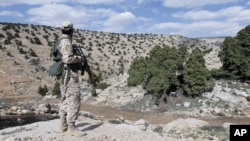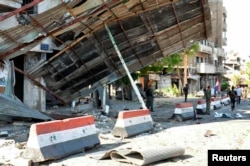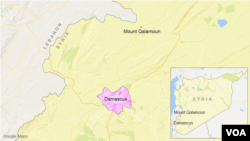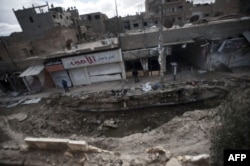Driven from northern Syria, Islamic State fighters are setting their sights elsewhere in the country — including the embattled suburbs of the capital, Damascus.
IS fighters attempted this week to infiltrate an area near Mount Qalamoun, a strategic rebel-held region in northeastern Damascus. Iran's proxy — Hezbollah — has been fighting on the side of the Syrian regime against rebels there for several years. The rebels have held their ground.
In recent days, IS fighters attacked from Homs and took some Syrian rebels hostage before they retreated. To close observers of the Syrian conflict, the IS raid signaled the militant group's future strategy.
"IS knows its departure from all northern Syria is inevitable," said Rami Abdulrahman, head of the Syrian Observatory for Human Rights, a group that monitors the country's civil war. He added that IS seeks vulnerable areas "to cover for its losses in other parts."
Rebel groups such as Jaish al-Islam and al-Rahman Legion have maintained a strong presence in the Damascus suburbs. Now IS wants to gain control of Qalamoun, some 50 kilometers northeast of Damascus, to use as a command center, according to local military leaders.
IS "wants to control Mount Qalamoun because this area is considered a gate to Damascus," Abdulrahman Abu Mansur, a commander with the al-Rahman Legion, told Shaam Network, a pro-opposition news site.
During the height of its expansion in early 2014, IS was able to build a network of local affiliates across Syria, particularly in Damascus, Homs and Daraa.
Pressuring Assad forces
Analysts say the primary mission of IS affiliates is to put pressure on Syrian President Bashar al-Assad's regime and opposition forces at the same time.
"When the Assad regime makes gains [in eastern Syria], IS has the capability to strike targets in western Syria that would otherwise be safely located in core regime-controlled areas," said Nicholas A. Heras, a Middle East researcher at the Center for a New American Security in Washington.
IS fighters last week successfully executed suicide attacks in government-held areas of Homs, Tartous and a checkpoint near Damascus. Dozens of Syrian troops were killed, according to the Islamic State website.
Clashes between IS and Assad forces in the eastern oil-rich province of Deir Ezzor have recently increased, with IS fighters trying to gain control of a strategic airbase held by government troops.
Government forces have reportedly made advances against IS in the countryside of Deir Ezzor, where IS has maintained control for more than two years.
Heras told VOA that with its operations in western Syria, IS strives to demonstrate to its adversaries "that it is still a deadly force to be reckoned with."
IS has recently gained influence in eastern Homs province in central Syria. Experts believe that the IS presence in Homs gives the group an advantage to gain footing in western and southern Syria.
Since its inception in 2014, IS hasn't been successful in holding territory near Damascus.
IS fighters briefly took control of parts of eastern Damascus — also known as Eastern Ghouta — in 2014. But local armed groups and other Islamist forces in the area swiftly pushed them out.







